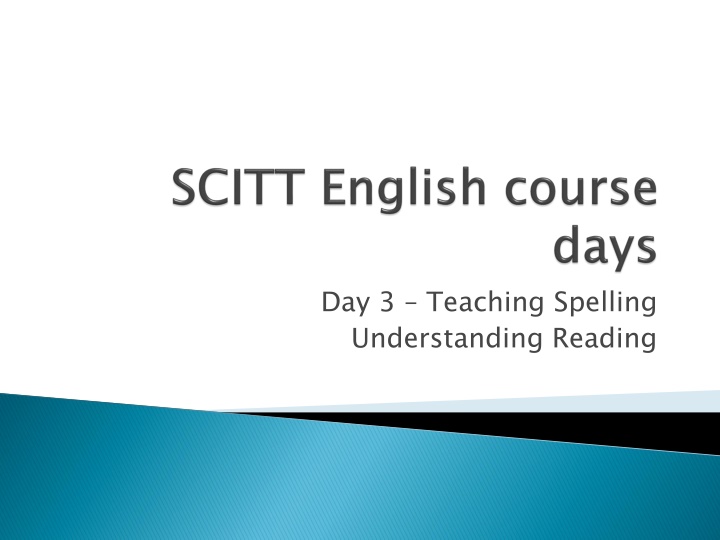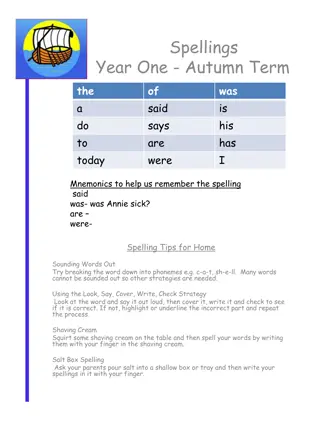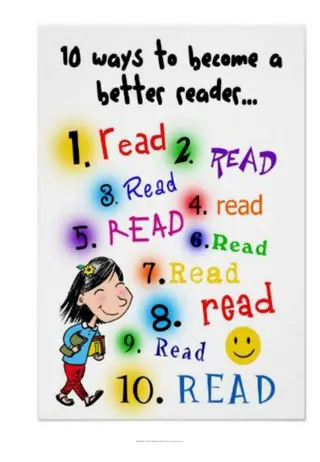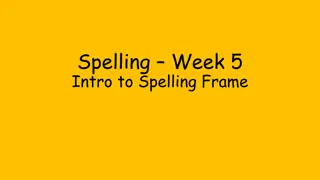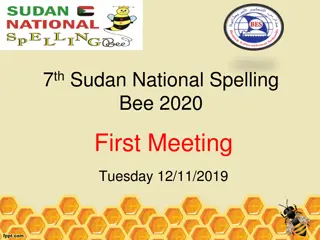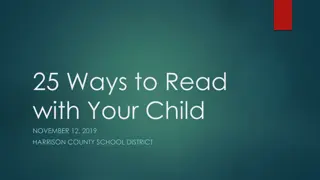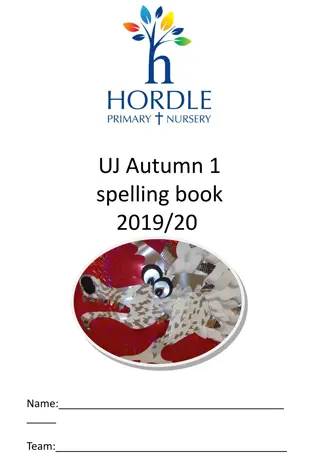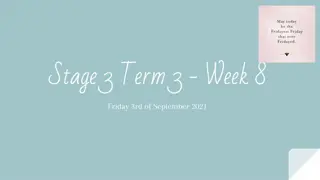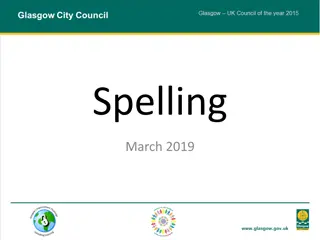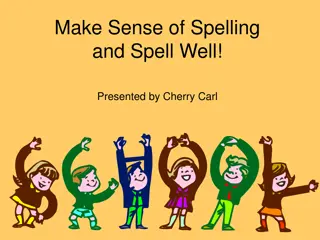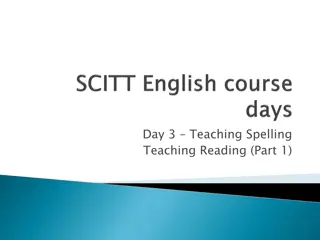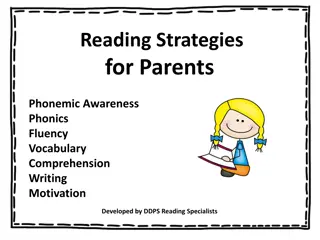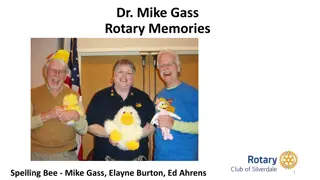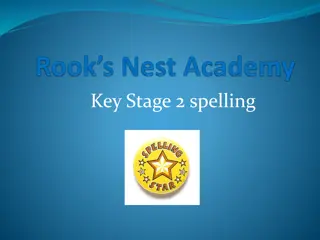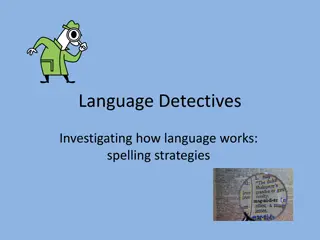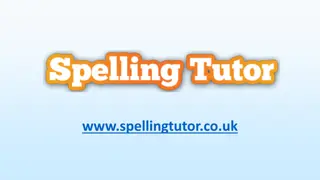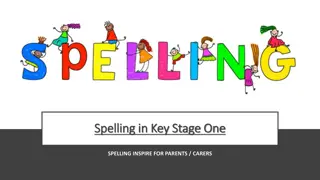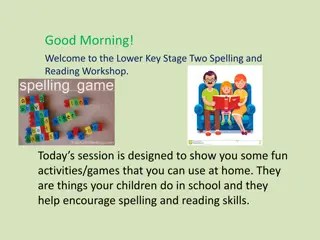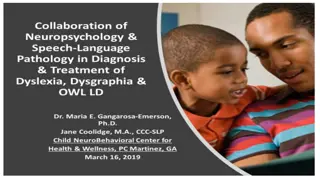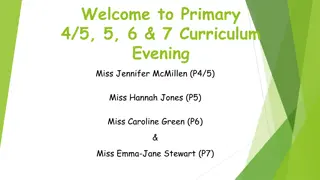Spelling Basics and Reading Skills for Day 3
Enhance your child's reading and spelling abilities with a focus on foundational skills. This educational material provides essential guidance for teaching spelling and supporting reading comprehension. Equip yourself with effective strategies to facilitate learning progress in these critical areas of language development. Dive into engaging activities and insightful content designed to promote linguistic proficiency and spelling mastery. Strengthen your teaching approach and nurture a love for language in young learners.
Download Presentation

Please find below an Image/Link to download the presentation.
The content on the website is provided AS IS for your information and personal use only. It may not be sold, licensed, or shared on other websites without obtaining consent from the author.If you encounter any issues during the download, it is possible that the publisher has removed the file from their server.
You are allowed to download the files provided on this website for personal or commercial use, subject to the condition that they are used lawfully. All files are the property of their respective owners.
The content on the website is provided AS IS for your information and personal use only. It may not be sold, licensed, or shared on other websites without obtaining consent from the author.
E N D
Presentation Transcript
Day 3 Teaching Spelling Understanding Reading
Phoneme Phonological awareness Graph High frequency word Grapheme Visual discrimination
Find out how your school teaches phonics and observe a phonics session. Write a reflective log outlining how this has developed your understanding of effective phonics teaching. How did your school transform and connect subject knowledge?
Effect is a noun (outcome, consequence or appearance) Affect is a verb (to transform or to change) What .......... did it have on your class Did the snow ............. your school? It was clearly ..........ing your teaching The ........... of the medicine was sudden. Watch out there is a rare verb: to effect (to bring into being) The new spelling policy will be effected from May
You will understand Spelling conventions How to teach spelling How to teach handwriting How reading fluency develops The reading comprehension skills
Fder ure u e eart on heofonum Si in nama gehalgod to becume in rice gewur e in willa on eor an swa swa on heofonum. urne ged ghwamlican hlaf syle us tod g and forgyf us ure gyltas swa swa we forgyfa urum gyltendum and ne gel d u us on costnunge ac alys us of yfele so lice Father our thou that art in heavens be thy name hallowed come thy kingdom be done thy will on earth as in heavens our daily bread give us today and forgive us our sins as we forgive those who have sinned against us and not lead thou us into temptation but deliver us from evil truly
Old English - Matching the Anglo-Saxon tongue to the Roman alphabet Middle English from the Norman Invasion, a vast influx of new words, prefixes and suffixes The Great Vowel Shift 1476 William Caxton arrives More Greek and Latin words from the Renaissance 1500s - Spelling reform
1755 - Dr Johnsons dictionary Noah Webster s dictionary Words from Empire Modern spelling Globalisation and the internet
Phonics Sight words Spelling conventions Morphology Etymology Visual discrimination Mnemonics Grammar related rules Proof reading Using a dictionary
Wall Gave Bread Boxes Brother Hair Fuss Buy Again Mice Seat Footprint Scary Change Wrong Switch Metal Fraction Clapped funniest
Creative Enough Reception Numb Division Sighed Navigation Thoughtful Offered Muscle Curiously Courage Disagreement Pyramid Excellent Generous Chorus Tongue Accidentally Deceive
Phonically regular words High frequency phonically regular words (easy words) High frequency phonically irregular words (tricky words) Words with spelling conventions Words that have to be specifically learned (challenging words)
The spelling of units of meaning within words Root words e.g. cycle Suffixes e.g. ing Prefixes e.g. bi Compound words e.g. motorcycle Etymology e.g. Cycle is from the Latin cyclus which is from from the Greek kyklos meaning circle, wheel, any circular body, circular motion, cycle of events etc.
How many morphemes in each word Horses Anticlockwise Prewashed Unchangeable Badger
Knowing the choice of graphemes for the sound and which are more likely Being able to break a word into phonemes, morphemes and syllables and deal with them one at a time Having a gut feeling about what looks right With these a child can then tackle a full range of spelling conventions With these a child can then tackle a full range of spelling conventions
Unusual or unique grapheme choices e.g. bdellium An inability to use analogy e.g. khaki Too many tricky parts in one word Lack of a clear convention A word never seen before Words that break the convention
Have-a-go pads Teaching children to try out different spelling options
Quickwrite Look, say, cover, write, check Spelling scribble Teach spelling strategies
Words within words e.g. To-get-her Beating the syllables e.g. Re-mem-ber Over-articulation e.g. Wed-nes-day Mnemonics e.g. Big elephants... Picture mnemonics e.g. The ee could become a pair of eyes in see Saying the names of the letters in rhythm e.g. Nec-ess-ary
Using phonics Using other spelling strategies Using dictionaries Trying out spelling options and making a visual choice In context
In all sections of the English lesson and across the curriculum Using a spelling teaching sequence across one lesson or a series of mini lessons Include spelling in success criteria
Revisit A chance to revisit conventions, HF words or graphemes recently taught. Teach / investigate A spelling investigation or direct teaching and explanation of how spelling convention works. Model examples and establish a definition. Practise Interactive activities to practise spelling convention. Could include whiteboard activities, games and challenges.
Apply and reflect Will commonly include children writing dictated sentences on whiteboards. These will contain challenging words, words and spelling convention words. Self assessment of what was correct and what was incorrect. How can you improve? What caused the issues? Assess A final assessment on whiteboards of HF words, words revisited and spelling convention words. Make every word count.
Not letting children get hung up on spelling but keeping the challenge Remembering that it is one small part of writing Developing a curiosity about words
Conventions not rules Helps children to identify patterns in spelling Best taught through spelling investigations Look for tricks and patterns, especially with word endings and suffixes
-le is the most common (table, apple) These often have a stick or a tail letter before the ending -al is much less common but comes next (local, usual) -el is less common still (camel, tinsel, squirrel) Both of these tend not to have a stick or a tail letter before the ending -ol and il are very rare (fossil, pistol)
-able is far more common Without the ending what are you left with? Agree- able Leg ible Can you say I am able to... If so, it is probably able Which ending: indestruct..., forgiv..., respons..., break...?
Antiseptic, anti-clockwise, antisocial, antibiotic, antidote, antifreeze, anticlimax, antithesis After using phonics and understanding anti as a convention, what is still tricky about these words?
Make conventions more rational More interesting and active Appeal to problem solving instincts Support for Spelling , Spelling Bank and the 2014 curriculum are good for this approach
1. Tell the children the objective 2. Introduce a set of relevant words 3. Children sort the words and identify conventions / patterns. Help children to hypothesise and test their ideas 4. Explain the principle behind the convention / pattern and model it 5. Explore variations and exceptions
You are learning the convention for adding the -ly suffix on to words Look at the list of words What is the convention and what are the exceptions?
Usually added to an adjective to form an adverb Simply added on to most root words If the root word Ends in a _y with a consonant before it is more than one syllable long Then change the _y to an i If the root word ends in _le then change that to an _ly If the root word ends in _ic then add _ally instead of _ly There are exceptions!
My hypothesis is that -ie- is always correct except when it follows a c. Then it is ei- Prove it or form a new hypothesis
Words within words Acrossword Shannon s game Finish (st.......p) Phoneme challenge Word stairs Human words Scrabble and Team Scrabble Spelling tennis Boxes
Spelling journals Sending home spellings that the child has actually got wrong Partner testing Synonyms for outstanding spellers
Their work Tests and assessments Test analysis Help for small groups Common issues Next steps?
Easy to navigate word displays Word banks Key words Have-a-go pads Phonic charts e.g. THRASS Dictionaries at different levels of difficulty The BIG teacher dictionary Thesauri Nightmare words!
Develop gross and fine motor skills first Link to phonics Join as soon as letters are formed correctly Adopt the school s style and use at all times Teach handwriting lessons little and often Teacher models Children practise Have consistent high expectations Know the school expectations of pen/pencil use and handwriting book use Develop the tripod pencil grip. Watch out for tense handwriting.
By the end of YR Pencil grip is correct By the end of Y1 All letters formed correctly By the end of Y2 Letters joined By the end of Y3 Writing in pen By the end of Y6 Developed a personal style
Long ladder (down and off in another direction) i, l, j, t, u One-armed robot (down and retrace upwards) b, h, k, m, n, p, r Curly caterpillar (anticlockwise round) c, a, d, e, e, g, o, q, f, s Zigzag letters v, w, x, y, z Handwriting issues Take a focused approach Ascenders and descenders
Developing Early Writing Letters and Sounds Support for Spelling Spelling Bank The 2014 Primary Curriculum
Day 2 Day 2 Day 3 Day 3 and 4 Day 5 From The National Reading Panel Report , 2000
A bridge between phonics and comprehension
Accuracy in word recognition decoding). Approximately 95% word recognition accuracy is considered adequate for instructional level reading. Automaticity in word recognition only are accurate in word recognition, they are effortless or automatic in recognizing the words they encounter. The significance of achieving automaticity is that readers can devote their limited cognitive resources to the important task of comprehending the text. Accuracy in word recognition (word Automaticity in word recognition. Readers not
